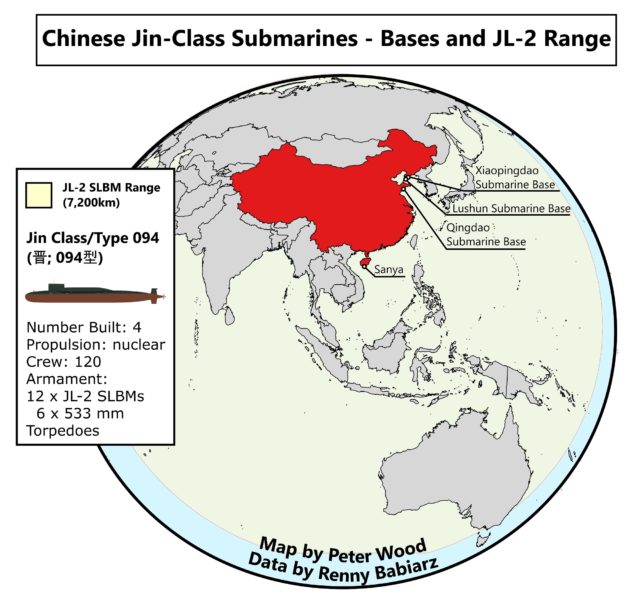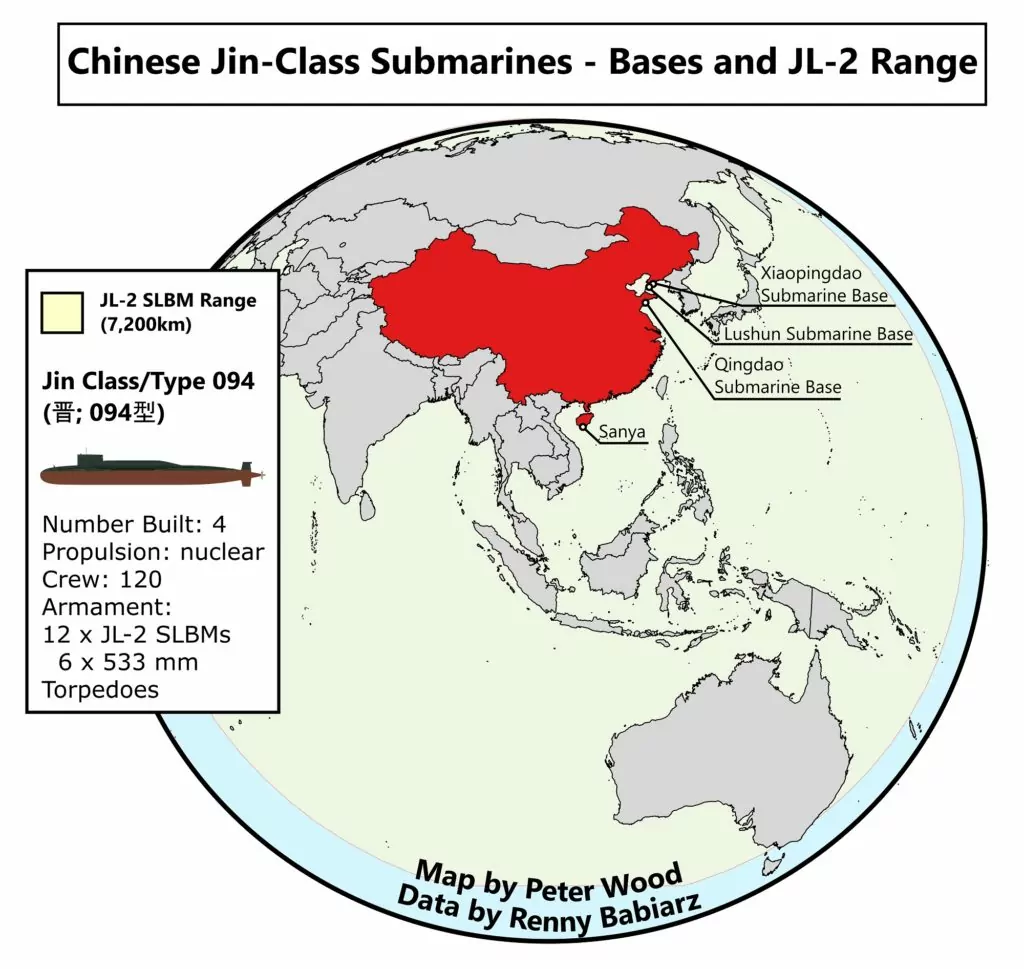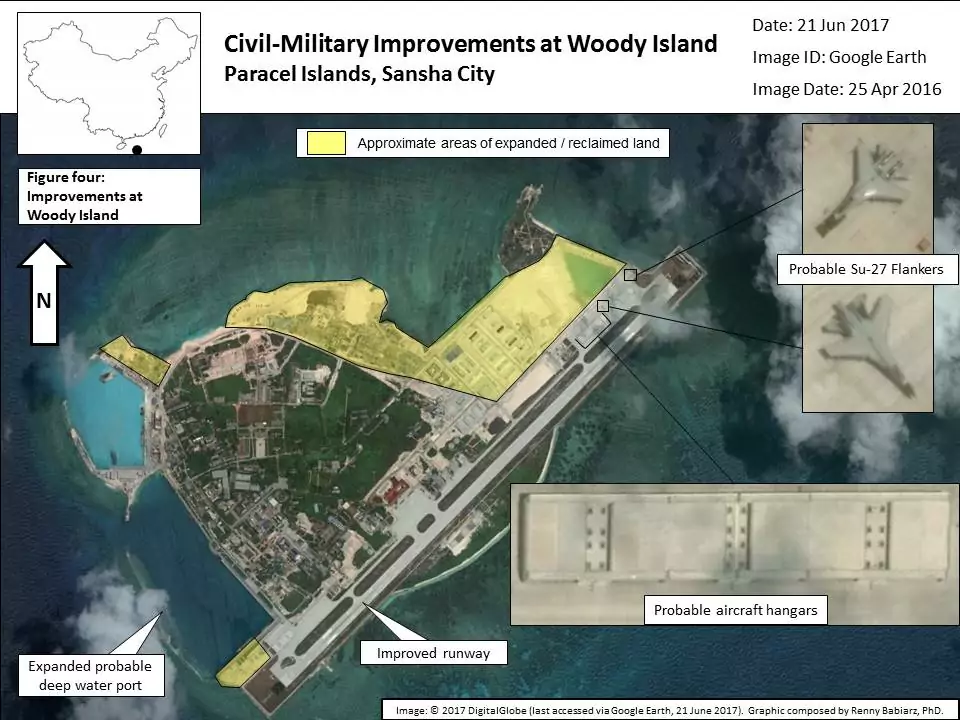
China’s Nuclear Submarine Force
Publication: China Brief Volume: 17 Issue: 10
By:

Over the past three years, China’s sea-based nuclear deterrent capability has noticeably improved, beginning with the first service deployment of a nuclear-armed ballistic missile submarine in 2014. Most recently, geospatial analysis conducted by AllSource Analysis has recently revealed four Jin-class (Type 094) ballistic missile submarines (SSBNs) at Longpo Naval Base on Hainan Island, supporting United States Department of Defense reports that China has at least four Type 094 SSBNs in service. [1] Available evidence shows that China’s development of a sea-based nuclear deterrent has been incremental, fits within generally accepted norms of nuclear deterrence strategy, and faces certain technical and geographic constraints that will most likely limit China’s nuclear deterrence patrols in the near future. [2]
China’s SSBNs have apparently entered into service with its South China Sea Fleet as China has improved and expanded its political administration and military occupation of maritime territory throughout the South China Sea. This has included the creation of islands with deep-water ports, runways, and various other administrative and storage facilities throughout the Spratly Islands along the western edge of the South China Sea. While this South China Sea territorial expansion has several effects—extending claims on energy resources and protecting critical sea-lanes—the most important outcome is that it facilitates unimpeded deployment of its SLBM force. As China’s SSBN force continues to expand and receive upgrades, this could have the eventual—and unprecedented— intent of China deploying a global nuclear deterrent from within the South China Sea.

China’s SLBM Program
China initiated its SLBM research during 1958 with the code name “1060” (later renamed Julang Yihao, or JL-1, 巨浪; in 1964), and received technical assistance and equipment from the Soviet Union towards this project. China constructed a naval base at Qingdao and a shipbuilding facility at Huludao as part of its early submarine development. [3] As research and development on SLBM systems continued during the late 1960s and into the 1980s, China conducted submarine nuclear propulsion trials at Hulu Dao shipyard, tested rocket components at Wuzhai Missile Test Facility, and conducted missile ejection tests in the Bohai Strait in association with nearby Xiaoping Dao and Lushun submarine bases (see figure 1). [4]
Development of China’s SLBM program was intermittent during China’s Mao-era political leadership (1949–1976) due to budgetary constraints, historical events (such as the Great Leap Forward, the Sino-Soviet split, and the Cultural Revolution), restricted access to oceans, and periodic strategic reassessments. [5] After the leadership ascension of Deng Xiaoping in 1978, China’s SLBM program received new emphasis, and 1982 marked the first successful test-launch of a JL-1 missile from a submerged Xia-class (Type 092) SSBN, China’s first generation of operational SSBNs. The Type 092 entered into service in the 1980s, yet probably did not conduct nuclear deterrence patrols given certain technical, geographic, and international security constraints. China’s current SSBN program, the Jin-class (Type 094), was initiated in the 1980s and carries the JL-2 missile with a range of approximately 7,200 kilometers (DOD, 2016). The first Type 094 SSBN entered into service by 2014, roughly 60 years after the initiation of China’s SLBM program, 35 years after China’s first successful test launch of a ballistic missile from a submerged submarine, and about 30 years after the initiation of the Type 094 SSBN program, underscoring the incremental pace of development for China’s SLBM capability.
South China Sea
The South China Sea is bounded by the Malacca and Singapore Straits in the west and the Taiwan Strait in the east, and lies between Vietnam, the Philippines, China, and Indonesia. An estimated 50 percent of global oil shipments pass through it, and surveys suggest there are projections of large oil and natural gas reserves under the seabed.
The Paracel Islands, located approximately 300 kilometers southeast of Hainan province’s southern coast, are generally recognized as being occupied by China after they dislodged Vietnam from these islands in 1974; they are still claimed by Vietnam and Taiwan. China’s expansion of infrastructure throughout the Paracels has been extensive ever since, and the area has recently been included in China’s domestic political administrative system.
In the Spratly Island region, located approximately 1000 kilometers southeast Hainan province’s southern coast, China has been expanding and improving its outposts since approximately 2014. China has reclaimed land and constructed civil-military facilities in the following seven areas of the Spratly Island region: Subi Reef, Gaven Reefs, Fiery Cross Reef, Hughes Reef, Johnson Reef, Mischief Reef, and Cuarteron Reef (DOD, 2015).
China’s Nuclear Doctrine and Evolving Nuclear Force Structure
China’s current nuclear doctrine is best characterized as a nuclear counterstrike strategy (核反击), which some scholars have summarized as “assured retaliation.” [6] Developing a secure counterstrike (or second strike) capability is a fundamental tenant of nuclear deterrence strategy, although corollary concepts such as minimum and limited deterrence vary in the importance placed upon this tenant. [7] China’s nuclear counterstrike strategy may be considered as either an independent nuclear counterstrike campaign or coordinated within a broader counterstrike campaign employing nuclear forces deployed in different services. [8] Although China has long worked to develop a more credible second strike capability, such as through improved road-mobile ballistic missile systems for its land-based nuclear forces, its deployment of a sea-based nuclear deterrent offers the most secure theoretical nuclear counterstrike capability.

China’s Type 094 SSBNs measure between 132–137-meters-long on satellite imagery, with a “humpback” (龟背) area in the vessel’s mid-section containing 12 ballistic missile tubes (figure 2) (The Paper, July 21, 2016). [9] The Type 094 is designed to carry the JL-2 ballistic missile with a range of approximately 7,200 kilometers (DOD, April 26, 2016). China’s four Type 094 SSBNs are probably based at Longpo Naval Base at Hainan Island as part of the South China Sea Fleet, and the nuclear weapons they carry are possibly controlled by the PLA Navy instead of China’s PLA Rocket Force (the force currently in charge of administering China’s nuclear forces). [10] Located nearby Hainan’s Yulin Naval Facility, the Longpo Naval Base was constructed between 2003 and 2010 and contains submarine piers, probable military administrative areas, a probable sea-based tunnel entrance, and a probable magnetic silencing facility (figure 3).
 China currently faces limitations regarding deployment of Type 094 SSBNs from Hainan Island based on interactions between the current international maritime security environment, technical features of the Type 094 SSBN, and maritime geography factors of the South China Sea. More specifically, Japan and the United States most likely deploy a variety of submarine surveillance systems throughout the East China Sea and the western Pacific, and operate sophisticated anti-submarine assets throughout the region. Type 094 SSBNs reportedly generate a level of noise while under sail that more easily allows for tracking and, in theory, targeting (IHS Janes, July 15, 2016). The maritime geography of the East and South China Sea offers limited access channels to the Pacific Ocean for open-ocean nuclear deterrence patrols. Taken together, these factors most likely constrain China’s deployment of its sea-based nuclear deterrent in the near term.
China currently faces limitations regarding deployment of Type 094 SSBNs from Hainan Island based on interactions between the current international maritime security environment, technical features of the Type 094 SSBN, and maritime geography factors of the South China Sea. More specifically, Japan and the United States most likely deploy a variety of submarine surveillance systems throughout the East China Sea and the western Pacific, and operate sophisticated anti-submarine assets throughout the region. Type 094 SSBNs reportedly generate a level of noise while under sail that more easily allows for tracking and, in theory, targeting (IHS Janes, July 15, 2016). The maritime geography of the East and South China Sea offers limited access channels to the Pacific Ocean for open-ocean nuclear deterrence patrols. Taken together, these factors most likely constrain China’s deployment of its sea-based nuclear deterrent in the near term.
To mitigate these constraints, China may adopt a “bastion” strategy that keeps its SLBM force within the South China Sea while maintaining a credible nuclear counterstrike. [11] A bastion strategy of SLBM deployment was a concept first applied to Soviet SLBM deployment patterns, wherein Soviet SSBNs with long-range SLBMs deployed within the Barents Sea, close to Soviet territory, due in part to U.S. superiority of submarine tracking in the open ocean. [12] In the case of China, such an approach would probably rely on developments currently underway that recast interactions between China’s SLBM technology and maritime geographic features of the South China Sea. In terms of technical advances, China may be developing a quieter variant of the Type 094 (the Type 094A), a longer-range ballistic missile for the Type 094 based on the JL-2 (sometimes termed the JL-2A), and is planning a next-generation SLBM system (the type 096) to be equipped with a next-generation ballistic missile, the JL-3 (DoD 2016, IHS Janes July 15, 2016). Yet it is China’s actions in the Paracel and Spratly Islands of the South China Sea that hold the greatest promise for advancing a possible bastion SLBM deployment strategy. While a full summary of China’s expansion in the South China Sea is beyond the scope of this article, several recent political and military developments bear mention.

Since 2012, China has expanded its political and military occupation of the Paracel Islands as part of its larger claim of national sovereignty over South China Sea. In 2012, China established formal political administration of the Paracel Islands by creating Sansha city (三沙市) on Woody Island (永兴岛) as part of Hainan province (海南省) (Sansha Government [accessed June 18]; AMTI, April 17). Additionally, China has improved civil-military infrastructure on Woody Island, to include the island’s airport and seaport areas, and probable military jets are observable on the island’s nearby runway hangars on satellite imagery via Google Earth (figure 4). China now promotes tourist visits to the area, and Woody Island has since been used as the subject of propaganda posters on China’s mainland territory promoting China’s sovereignty over the entire South China Sea (Sansha Government Tourist Info [accessed June 18]).
In the Spratly Islands, China has expanded and improved seven areas, in some cases creating new landforms where only underwater reefs existed before. At Subi Reef, Gaven Reefs, Fiery Cross Reef, Hughes Reef, Johnson Reef, Mischief Reef, and Cuarteron Reef, China has expanded physical territory through land reclamation, built new probable administrative facilities, and constructed deep water ports (see figure 5).

At Mischief Reef, Subi Reef, and Fiery Cross Reef, China has constructed runways between 2.8-3.1kilometers-long. Additionally, China has most likely upgraded aviation and naval-related navigation communication systems through occupied areas of the South China Sea region. [13] As a result of these improvements, China has improved it capacity for coordinating and hosting a range of civil-military activity throughout the southern and eastern portions of the South China Sea.
Conclusion
While China’s emergent sea-based nuclear deterrent is a new military capability, it has been long expected and fits well-established expectations of nuclear deterrence strategy. Further, China’s deployment of its SLBM systems faces certain constraints in the near term related to the current international security environment, maritime geographic factors in the South China Sea, and certain technical aspects of the Type 094 SSBN. Future technical improvements to China’s SLBM capability are to be expected and bear close observation. Yet it is the interaction of such technical advances with the reshaped maritime geography in the South China Sea that offers China the requisite political and military support for regular nuclear deterrence missions in the future. China’s future deployment of longer-ranged SLBMs within this reshaped maritime environment could facilitate global nuclear deterrence patrols from within the South China Sea.
Even in the absence of a bastion strategy, China’s expanded political and military occupation of areas within the South China Sea has nonetheless improved its capacity for deploying its SLBM force in the Asia-Pacific region. Politically, China is developing administrative jurisdiction over areas of the SCS that legitimate the deployment of military assets in the region. Militarily, China can host and coordinate greater numbers and types of naval vessels, and can provide improved air transport and combat support. Seen in this light, China’s emergent sea-based nuclear deterrent is one part of a much broader expansion of China’s presence in the Asia-Pacific region.
Renny Babiarz received his Ph.D. from Johns Hopkins University where he wrote his thesis on of China’s nuclear weapons program. He previously served as a geospatial analyst for the National Geospatial-Intelligence Agency, and currently works as a research analyst for AllSource Analysis. You can follow him on Twitter @RennyBabiarz
Notes:
-
“China’s Emerging Sea-Based Nuclear Deterrent,” AllSource Analysis; Department of Defense, “Annual Report to Congress: Military and Security Developments Involving the People’s Republic of China 2016.”
- Renny Babiarz, “China’s Sea-Based Nuclear Deterrent: Incremental Advances and Perennial Limitations.”
- Lewis, John and Xue Litai. China’s Strategic Seapower: The Politics of Force Modernization in the Nuclear Age (Stanford, CA: Stanford University Press, 1994).
- Babiarz, Renny. “The People’s Nuclear Weapon: Strategic Culture and the Development of China’s Nuclear Weapons Program.” Comparative Strategy 34 (5): pp. 422-446.
- For primary sources on China’s nuclear doctrine, see Wang Houqing and Zhang Xingye, The Science of Military Campaigns (2000) and Yu Jixun, Second Artillery Campaign Studies (2004), specifically 11 (force protection with the ability to counterstrike, general); For two excellent secondary sources using the phrase “assured retaliation,” see Fravel and Medeiros, “China’s Search for Assured Retaliation” and Eric Heginbotham et. al., China’s Evolving Nuclear Deterrent, the latter of which provides an excellent literature review of Chinese military primary source and secondary source materials related to China’s nuclear doctrine.
- A minimum deterrence posture relies upon the mere existence of a nuclear capability to deter, while limited deterrence entails a more secure nuclear retaliatory force. See Patrick Morgan, Deterrence Now, for a complete over of these and other nuclear deterrence concepts.
- Yu Jixun, Second Artillery Campaign Studies, pp. 297 generally discusses nuclear-armed submarines as acting with nuclear-armed air and land-based systems as part of an overall nuclear counterstrike campaign.
- Historically, China decided to design and build nuclear attack submarines (SSNs) first, and then based designs for an indigenous SSBN using the nuclear attack submarine; China based designs for its Jin-class 094 SSBN on a nuclear attack submarine – possibly the Shang-class Type 093 SSN – with missile tubes “plugged” into the midsection of the vessel (see Jane’s Navy International, “Strategic Power: SSBNs Maintain Course in Evolving Security Environment,” and John Lewis and Xue Litai,China’s Strategic Seapower, for more on these developments).
- Jane’s Navy International, “Strategic Power: SSBNs Maintain Course in Evolving Security Environment.” Bastion could be translated as either棱堡 or堡; this source uses the term“棱堡” and describes it as a Soviet plan: “中国加速造航母 或派两艘驻南,” The China Press, 15 February 2017, accessed 11 June 2017 https://ny.uschinapress.com/spotlight/2017/02-15/113864.html. Another source uses the term “堡垒” to characterize the use of the South China Sea as an area of consolidated space for nuclear submarines, similar in principle to the Soviet bastion concept: “南海变内湖 陆巩固核潜艇堡垒海域,” China Times, May 13, 2016, accessed 11 June 2017, https://www.chinatimes.com/cn/realtimenews/20160513004129-260417.
- Gjert Lage Dynal, “50 Years Ago: The Origins of NATO Concerns about the Threat of Russian Strategic Nuclear Submarines.”
- “Geolocating Propaganda: Outdated Image of Woody Island in the Paracel Island Chain used in People’s Republic of China’s South China Sea Propaganda Poster.” Rennybabiarz.wordpress.com. June 2, 2017. https://rennybabiarz.wordpress.com/
- “China’s Emerging Sea-Based Nuclear Deterrent,” AllSource Analysis; Department of Defense, “Annual Report to Congress: Military and Security Developments Involving the People’s Republic of China 2016.”
- Eric Heginbotham et. al., China’s Evolving Nuclear Deterrent, p. 107.Historically, China decided to design and build nuclear attack submarines (SSNs) first, and then based designs for an indigenous SSBN using the nuclear attack submarine; China based designs for its Jin-class 094 SSBN on a nuclear attack submarine – possibly the Shang-class Type 093 SSN – with missile tubes “plugged” into the midsection of the vessel (see Jane’s Navy International, “Strategic Power: SSBNs Maintain Course in Evolving Security Environment,” and John Lewis and Xue Litai,China’s Strategic Seapower, for more on these developments).




